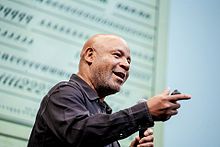Emory Douglas
Emory Douglas (born May 24, 1943 in Grand Rapids , Michigan ) is an African - American graphic artist . He was a leading member of the Black Panthers as their Ministers of Education ( Minister of Culture ). He designed the weekly party newspaper The Black Panther from the beginning (1967) until it ceased publication in 1979.
Life and political work
Douglas studied graphics and worked for black cultural-political projects; He designed sets for plays by Amiri Baraka when he heard about the Black Panthers and offered them his services. He designed the party newspaper from the first issue and drew the graphic comments and visual propaganda for the paper, which was extremely popular at times. Douglas' heroes and heroines symbolized the Black Panthers on paper and on posters , like the youngsters in black leather uniformed and armed with guns demonstrating on the street. He gave the Panthers even then a Gangsta - Image . The semi-realistic caricatures and their speech bubble slogans prompted immediate militant struggle. The aim of the Maoist party propaganda was to present the blacks in the ghettos as heroes, not as helpless victims, but convinced of the cause of the party and so ready to fight and kill.
The well-known youth author Frederik Hetmann enthusiastically quoted the poem There is a pig upon the hill. / If you don't kill him, / the Panthers will and the Regensburg paperback books showed a suitable graphic.
Douglas learned his trade in prison while serving in the Youth Training School in Ontario , California , where he was able to work in the prison print shop. He then studied graphics at the City College of San Francisco when he met Bobby Seale and Huey Newton .
Exhibitions
The Museum of Contemporary Art in Los Angeles dedicated a large exhibition to him as Black Panther and his revolutionary art in their graphic museum from late 2007 to early 2008. In England, a similar exhibition was held in 2009 at the Urbis Arts Museum in the middle of Manchester . Here, however, the context in which the work was created was also presented and the once exciting lives of the young revolutionaries were highlighted. Douglas held courses with children and their imitations of his work were then also exhibited.
literature
- Huey Newton : Self Defense . Verlag Roter Stern, Frankfurt am Main 1971, (With Emory Douglas graphics from the Black Panther ).
- Sam Durant: Black Panther. The Revolutionary Art of Emory Douglas . Rizzoli, New York NY 2007, ISBN 978-0-8478-2944-6 .
Individual evidence
- ↑ The Black Panther reportedly had a weekly circulation of 139,000 in 1970. Colette Gaiter, Visualizing a Revolution: Emory Douglas and The Black Panther Newspaper , AIGA , June 8, 2005. (English)
- ↑ Compare the heading of Jessica Werner Zack's article, The Black Panthers advocated armed struggle. Emory Douglas' weapon of choice? The pen , San Francisco Chronicle , May 28, 2007 (English). In fact, Douglas is still uncritical about the strategy and tactics of the Black Panther Party
- ↑ For the lecturer Colette Gaiter, Douglas is the most fruitful and persistent graphic agitator of the black power movement in the USA. Douglas has a deep understanding of the power of images in conveying ideas. Regarding Douglas ideology, Gaiter notes that Douglas has two ideas. The revolution should be understood as a necessity, so the conditions in the ghettos had to be shown Douglas's images served two purposes: first illustrating conditions that made revolution seem necessary . The situation should be immediately understood as revolutionary. But one also had to have the will to exploit the objectively revolutionary situation. A visual mythology of recognizing the power of the poor had to be created. The ideal should not be the middle class, but the Lumpenproletariat: and second, constructing a visual mythology of power for people who felt powerless and victimized. Most popular media represents middle to upper class people as "normal." Douglas was the Norman Rockwell of the ghetto, concentrating on the poor and oppressed . Douglas was the Norman Rockwell of the ghetto, and his drawings expressed respect and affection for the poor and the oppressed. But Colette Gaiter hardly takes notice of the lust for murder propagated in the Black Panther and the dehumanizing hatred of the so-called oppressive pigs ( the pig , pigs), after all , her article mentions the usual Panthers name for her opponents, pigs . The Black Panthers (with Mao, Fanon, Sartre, Sorel) considered feelings of hatred to be essential in order to create poor people's dignity in the fight against Babylon among the oppressed .
- ↑ Black Panther: The Revolutionary Art of Emory Douglas at the MOCA Pacific Design Center
Web links
- Black Panther: The Revolutionary Art of Emory Douglas : Museum of Contemporary Art Exhibit (October 21, 2007 - February 24, 2008).
- Historic limited edition fine art prints by Emory Douglas
- Interview with Emory Douglas
| personal data | |
|---|---|
| SURNAME | Douglas, Emory |
| BRIEF DESCRIPTION | American political artist and Black Panther Party activist |
| DATE OF BIRTH | May 24, 1943 |
| PLACE OF BIRTH | Grand Rapids , Michigan |
